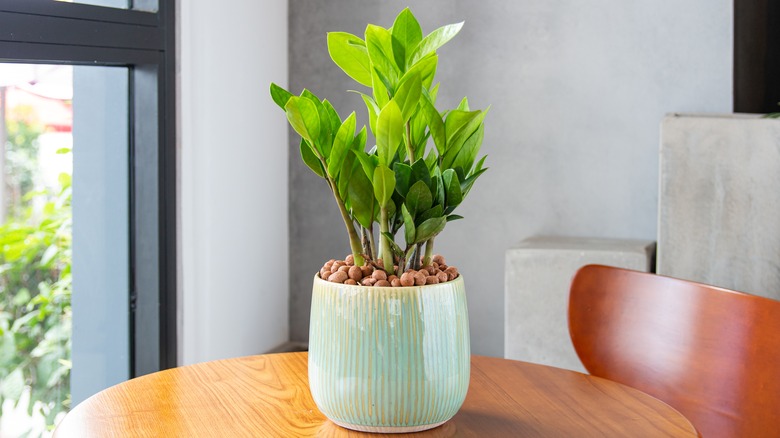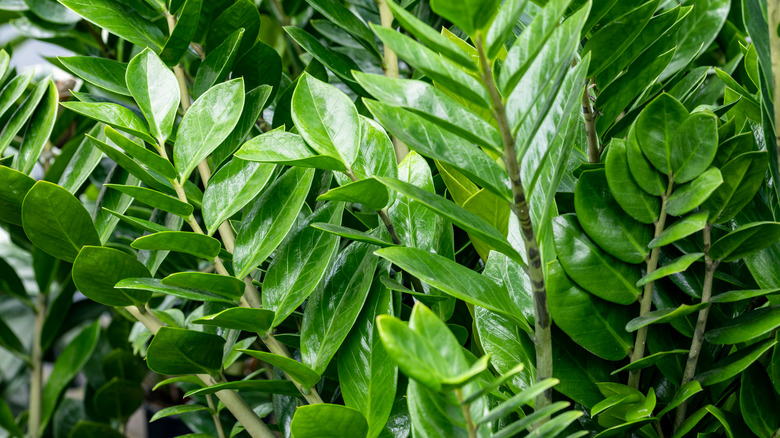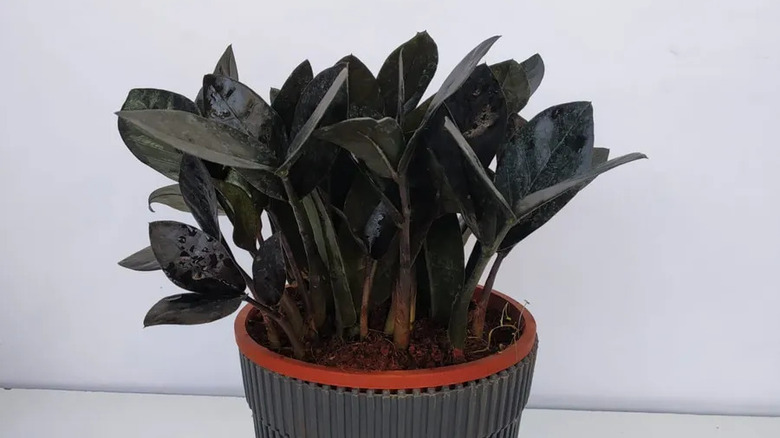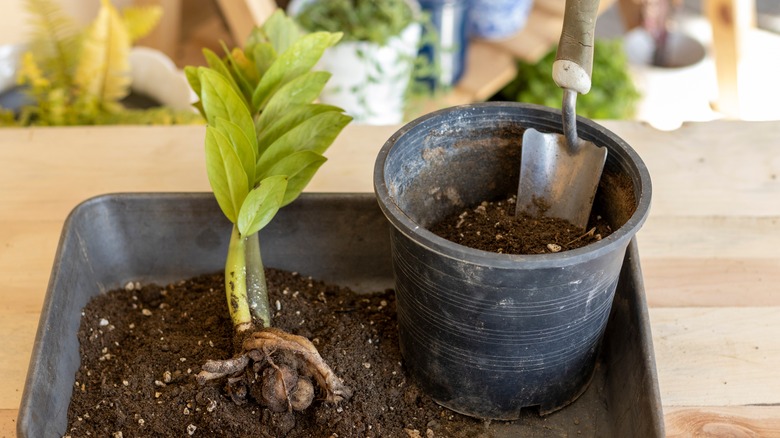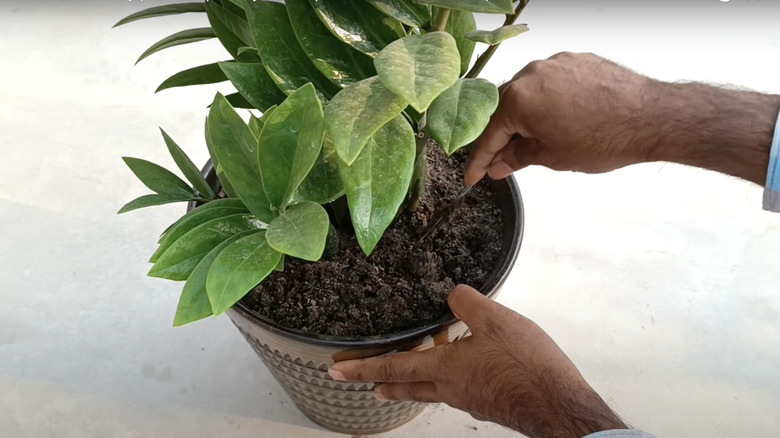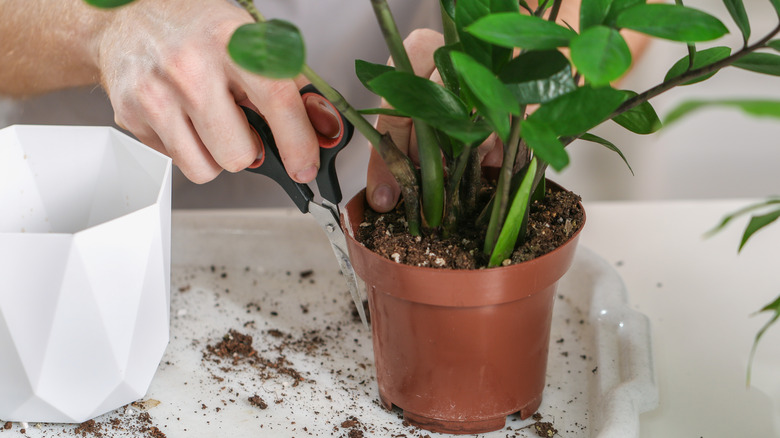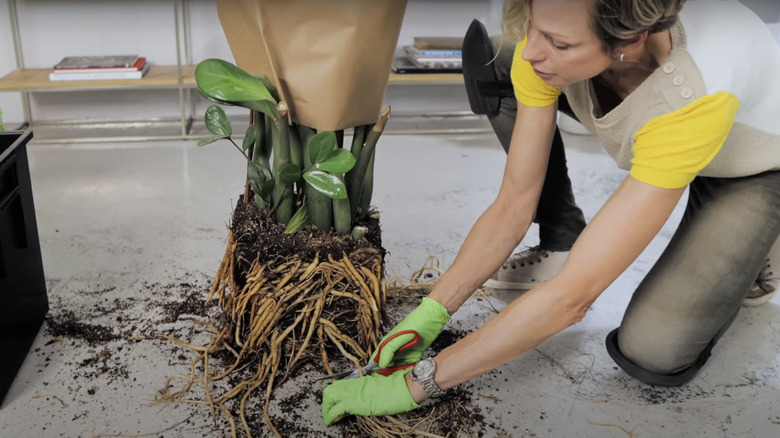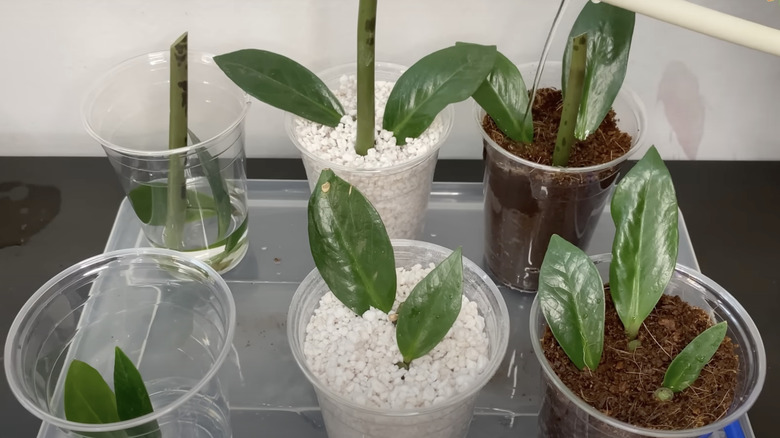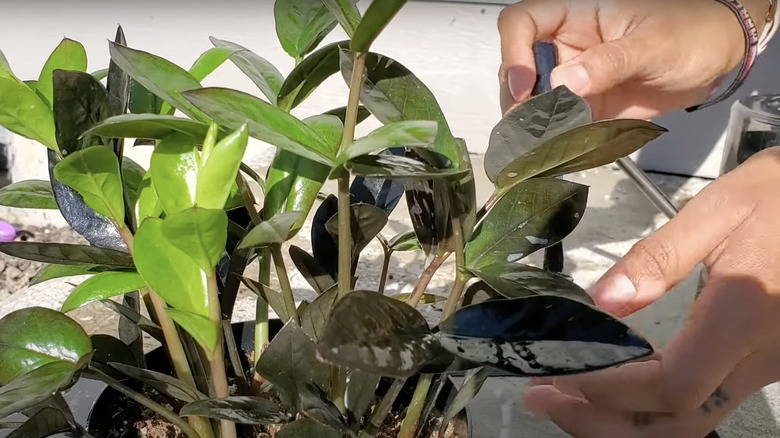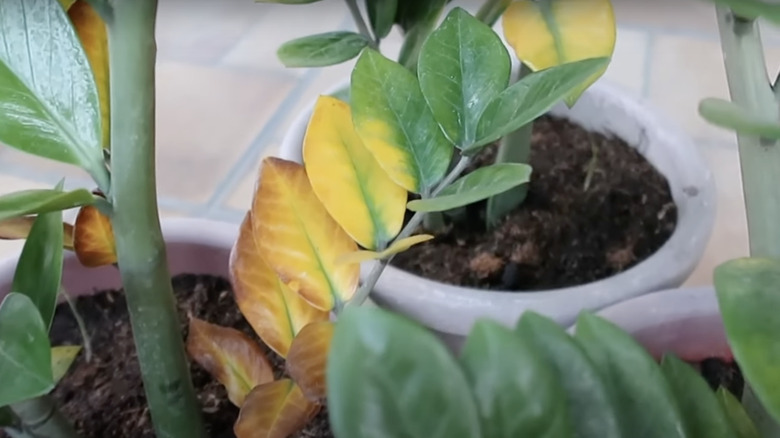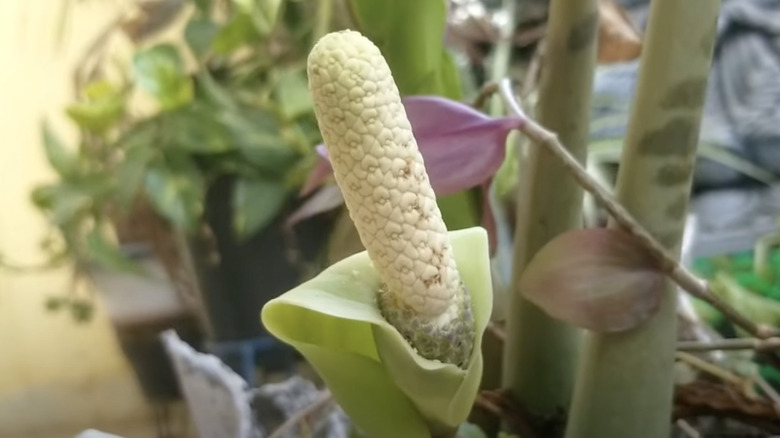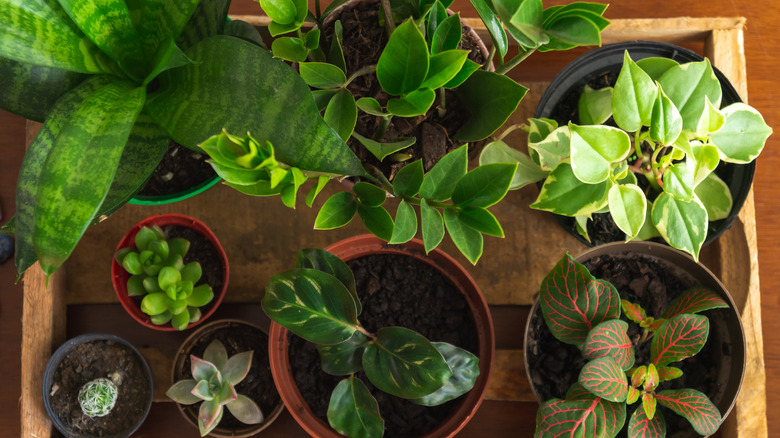How To Care For A ZZ Plant
Society has taken a recent interest in sustainability and "cottagecore" aesthetics, and it's no surprise that raising houseplants has become a popular hobby as a result. People from all walks of life enjoy this wholesome hobby of cultivating greenery, whether on a vast estate in the country or in a compact apartment in the city. The Zamioculas zamiifolia plant is a favorite among plant enthusiasts, though many know this species by other names. It's most commonly known as a ZZ plant but also referenced to as the Aroid palm, Emerald palm, Zanzibar gem, or Zuzu plant.
These plants are favored for interior decorating and outdoor gardening due to their rich green leaves that retain their vivid color year-round. While most ornamental foliage is beloved for its flower blooms, ZZ plants don't need to bloom to enliven indoor or outdoor spaces. These plants are highly valued because they aren't fussy and generally easy to care for, making them sublime plants for people of varying skill levels and gardening knowledge. Their adaptability allows them to survive in office spaces, homes, and garden beds with minimal care, though you should still be aware of the basics. Like all plants, they require unique fertilizing practices, watering routines, pruning work, and other general caretaking, which you can learn more about in the article below.
Understand how ZZ plants exist in nature
ZZ plants are especially remarkable for their unique look that is evocative of plants that existed during the time of the dinosaurs. Their glossy dark green leaves are oblong in shape and feather out from an upright stem, known as a "pinnate" formation. When they are healthy and kept in excellent conditions, they form unique off-white flowers similar to other plants in the Araceae family, such as peace lilies and elephant ears. In the wild, these plants thrive in grasslands and on the outskirts of forested areas in southeastern Africa, often in the cover of taller grasses and trees.
Native to Africa, ZZ plants are resilient to drought-like conditions and grow from thick underground rhizomes. These rhizomes are shaped like potatoes and are attached to a complex root system that supports the plant throughout its life. The rhizomes store water for the entire plant to rely on during dry periods, making this species ideal for people who are forgetful and don't remember to care for their plants on a daily basis.
Choose your favorite variety of ZZs
Most plant cultivars are a result of intentional cross-breeding by people, and ZZ plants were first propagated in this manner in 1996. There are three varieties most popular for retail purchases, and they are the original, Dowon, and Zenzi varieties. All three types share similar physical characteristics, most notably, their thick pinnate leaves that splay out from the main stems.
Original ZZs are easily the most common variety, and you can easily find them online, at chain home improvement and gardening stores, and in local nurseries. This type has dark green leaves on a slightly lighter green stem. Dowon ZZs grow more slowly and have dark purple leaves instead of green. The leaves and the height of the entire plant also tend to be shorter than standard ZZ plants. The third most popular, Zenzi, are the dwarf variety, and they have the same green leaves as the original plant but grow more compact. The plant itself is much smaller in size, only reaching ten to twelve inches at full maturity. Although these three are the most commonly found, there are also types like Chameleon, Luckywhit, Dark Zamicro, and others. Generally, the largest difference between the different varieties is their colors which range between yellows, greens, purples, and blacks.
Follow recommended planting practices for indoor and outdoor areas
Many homeowners struggle to find houseplants that can survive without bright sunlight throughout the day. If your home is very close to another building or stands in the shade of outside trees, you'll be happy to know that ZZ plants will thrive in such conditions. These plants prefer indirect sunlight for a minimum of six hours per day and never require direct sun. This makes them ideal indoor plants for downstairs rooms and workspaces. However, they can also thrive in outdoor gardens as long as they are planted in the shade.
When planting them inside or outside, make sure you use the right soil combination. Any well-draining soil with perlite, wood chips, and pumice fosters a healthy ZZ plant environment. Once planted, you should avoid transplanting your plant often– every two years or so should suffice. If the location you chose isn't humid enough for your ZZ plant, you may notice brown edges start to form around its leaves. Adding a humidifier to a room should take care of this issue, and you should aim to maintain your plant space at around 50% humidity.
Nurture ZZ plants as they grow
Planting is only the first step in caring for ZZ plants. Once your plant has taken root, you must nurture it with proper watering, fertilizing, and other general caretaking tips. Remember that these plants are built like succulents, and their root systems and rhizomes hold substantial amounts of water. With this in mind, you should water them sparingly. How often you should water your plant will vary depending on the ZZ's sun exposure and the climate surrounding it, but they usually only need watering when their soil becomes fully dry from top to bottom. In fact, some plant owners only hydrate this species once per month.
You should fertilize these plants even less than you water them, only adding nutrients to their soil twice per growing season; once at the start of spring and once at the beginning of summer. Use a fertilizer with the numbers 4-5-5 or 5-5-5. These numbers represent the three primary macronutrients for plants: nitrogen, phosphorous, and potassium. The ratio on fertilizer bags explains how much of each nutrient is in the mixture, and ZZ plants prefer a balanced set of numbers. Choose a type that is water-soluble and fast-release, and dilute this fertilizer to half-strength before you apply it. Quick and water-soluble fertilizers give you more control over what you're feeding your plant, ensuring you don't accidentally over-fertilize a mostly self-sufficient ZZ plant.
On a final note, there are some signs you should watch for to ensure you don't incorrectly water or fertilize your plant. If your plant isn't growing and its leaves are thin, droopy, and discolored, it may need more hydration and nutrients. However, be careful not to mistake yellow spots on the leaves for a lack of sustenance. While general yellowing of the leave implies neglect, yellow spots and damaged roots are signs of too much fertilizer and water.
Prune your ZZ plants as needed
Many species of self-sufficient plants are also sensitive to human interactions, but ZZ plants are not one of them. These plants are highly tolerant when it comes to pruning and trimming away extra growth, even though this practice is usually unnecessary. Many people put shears to their ZZs to remove diseased or damaged foliage, cut back sections of awkward growth, or remove stems and leaves for propagating purposes. You can snip off individual leaves or entire stems as needed, and these plants always grow back if they're healthy and their root systems and base stems are left intact.
Before you start cutting, make sure your gardening shears or scissors are disinfected by washing them with vinegar and water or soaking them in diluted bleach and letting them fully dry. If you have multiple plants, it's recommended that you clean the scissors or shears between each one to prevent the risk of spreading diseases, infections, and pests. Like people, plant diseases can spread by physical contact, which makes sterilization very important.
Consider the toxicity of ZZ plants
Your plant's health shouldn't be the only concern when pruning a ZZ plant. This plant naturally produces a compound called calcium oxalate, which is present in all parts, including its stem, leaves, and roots. This compound is usually protected behind the waxy coating that covers the leaves; however, when you cut it open, you can expose yourself. When calcium oxalate makes contact with skin (or is ingested), swelling, irritation, and digestion issues can develop. You should wear gloves while treating your foliage and throw away any plant pieces that fall to minimize the risk of exposure.
Pet owners, parents, and guardians should be extra careful if they have animals and young children in their homes. According to Anthony Manoguerra, the director of the San Diego Division of the California Poison Control System, his center receives thousands of calls a year due to children consuming house plants (via LA Times). This is not uncommon, and you should take extra steps to protect your plant and others from unfavorable interactions. Keep your plant elevated on a table or shelf that is out of reach, or keep the room closed and locked. If you have cats, keeping them from the plant may be a bit harder since they have the agility to reach higher places. Try placing citrus peels, coffee grounds, and diluted vinegar around your house plants. Dogs and cats are deterred by these sharp scents, making them less likely to feast on the toxic leaves.
Use best practices when propagating
Once you discover the easiness of raising and caring for a ZZ, it's likely you'll want more to add to your collection. Instead of buying more plants, many people opt to grow their own instead through a process called propagation. Propagation is when you develop a new plant from the parts of a healthy and fully matured one. There are three main ways to propagate; through stem cuttings, leaf cuttings, or division, and ZZ plants can be multiplied through all three methods.
When propagating through the stem method, you should choose a line of growth with healthy leaves and no signs of disease. Make sure you cut off a piece that won't make the parent plant look asymmetrical or bare in any one place since you don't want to sacrifice the aesthetics of your current plant to start another. Cut at least a four-inch long piece, remove the leaves, and root the stem in either water or soil. Water makes it easier to see your propagation's progress, but soil usually leads to healthier root development, so the choice is up to your preference. You can either use the leaves from the cut stem or cut more leaves from the parent plant to propagate through the second method. Standard practice is to place the leaves in soil or water, standing straight up, with most of the leaf exposed. The third method of propagation is reserved for larger plants. It's the process of basically cutting one plant in half to create two. You'll need to carefully pull your ZZ plant apart and unwind the roots, making cuts where necessary along the way. If you leave enough roots on both sides of the divided plant, they will survive as separate growths.
Watch for signs of plant pest infestations
Now that you know how to plant, care, and multiply ZZ plants, you should also be aware of outside factors that can impact their health and appearance. They are generally resistant to pest infestations since they are rarely watered or fertilized, making them lack moisture that attracts bugs. They may be resistant to these conditions but are not immune, and even though bugs prefer other plants, your ZZ plant can still be infected. Brown scale and aphids are small bugs that cling to the thick leaves of these plants, sucking up their sap and nutrients. They leave a gooey residue behind and cause the leaves to turn yellow, droop, and eventually fall. Mealybugs also feed on plant sap, leaving a powdery substance behind that attracts ants. Many of these bugs can be wiped off of your plant leaves with mild soap and water, but this is a temporary solution. If you want a more permanent solution for your bug problem, you'll need to take more drastic measures.
Many gardeners swear by plant-based oils, like neem oil or insecticidal soap, to coat plants and remove infestations. When these formulas soak your leaves, they also cover the insects, causing them to suffocate and die off. If these organic methods don't work, you may need to consider something more drastic, such as pesticides, though you'll need to be very careful in both indoor and outdoor locations.
Properly treat common ZZ ailments and diseases
Insects aren't the only afflictions that can harm your greenery, and lIke people and animals, plants are also susceptible to diseases. Southern blight is a common issue in humid and warm climates and starts by turning the bottom-level leaves a yellowed color. It slowly spreads into the roots, transforming them and the rhizome into a gooey mess. You need to stop this problem early to save your plant, and to do so, you must remove all affected leaves and remove any dead foliage from the soil around the plant.
If you have other plants, you've likely heard of root rot, which is a condition caused by overwatering. The first signs of root rot are in the leaves, as they begin to yellow and their tips turn brown. Many people mistake the early symptoms as underwatering since plants appear dried up and begin to shrivel. However, if you take a look at their root system, you'll see that it's highly saturated. Unfortunately, this condition cannot be reversed. You'll need to remove any affected parts of the plant and uproot it to replace the soil. If enough healthy roots remain, they will power through and begin their regrowth.
Know what to expect as ZZ plants mature
Once they reach full maturity, ZZ plants stand as tall as five feet and spread as wide as two feet. This takes years of growing, transitioning to bigger pots, and maintaining optimal conditions. They can grow one to three new stems and rise six to twelve inches taller a month, though this range is likely given for ZZ plants in brightly lit areas or outdoors. They tend to grow much slower in interior conditions, especially if never exposed to direct light.
Even if your plant is visibly growing, you shouldn't expect a bloom until it is at least five years old. In fact, ZZ plants rarely bloom at all, so don't be surprised if your plant never sprouts its unique corn-on-the-cob shaped flowers. These flowers only last about two days if they do show up, and they aren't guaranteed to bloom the next time around. These plants live for about a decade, and since the flowers are difficult to encourage and scarcely happen, it isn't something you should get too hung up over.
Add recommended companion plants for ZZs
Once you have one plant, you're bound to want more. Whether your ZZ plant is your first houseplant or one of many, you should know that there are many species that make excellent companions. The key to choosing the right companions for a pre-existing or planned plant collection is finding ones that thrive under similar conditions. This goes without saying, but you should prioritize choosing plants that will be healthy in their designated environment over those that simply fit your aesthetic.
If you're lucky, you'll be able to find plants that have the look you're going for and prefer the same indirect light as ZZs. Snake plants, also known as Dracaena trifasciata, have sword-shaped fleshy leaves and also thrive in medium to low light with low maintenance. Prayer plants (Maranta leuconeura) and Philodendrons are also great choices, although they require slightly more care than the options mentioned above. Of course, you can always opt for houseplants that like a little more sun and place them in a way that shields your ZZs from excess light, making them exceptional companion plants as well.
